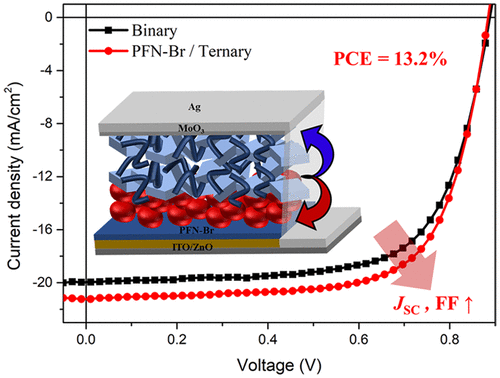当前位置:
X-MOL 学术
›
ACS Appl. Energy Mater.
›
论文详情
Our official English website, www.x-mol.net, welcomes your
feedback! (Note: you will need to create a separate account there.)
13.2% Efficiency of Organic Solar Cells by Controlling Interfacial Resistance Resulting from Well-Distributed Vertical Phase Separation
ACS Applied Energy Materials ( IF 5.4 ) Pub Date : 2020-03-12 00:00:00 , DOI: 10.1021/acsaem.0c00218 Hee Seon Park 1 , Yong Woon Han 1 , Hyoung Seok Lee 1 , Sung Jae Jeon 1 , Doo Kyung Moon 1
ACS Applied Energy Materials ( IF 5.4 ) Pub Date : 2020-03-12 00:00:00 , DOI: 10.1021/acsaem.0c00218 Hee Seon Park 1 , Yong Woon Han 1 , Hyoung Seok Lee 1 , Sung Jae Jeon 1 , Doo Kyung Moon 1
Affiliation

|
Two strategies were investigated to improve the efficiency of organic solar cells (OSCs) with the aim of controlling the interfacial resistance in the devices: the use of a ternary active layer and the introduction of conjugated polymers. The ternary active layer was formed by introducing PC71BM between a high-performance non-fullerene photoactive material P(Cl–Cl) (BDD = 0.2) and the IT-4F-based binary active layer, thereby reducing the interfacial resistance between the donor and acceptor via vertical phase separation. Furthermore, the introduction of the conjugated polymer PFN-Br created a well-dispersed separation attributable to enhancement of the interfacial contact with the active layer and simultaneous reduction of the interfacial resistance. Consequently, the synergetic effect of the ternary active layer and PFN-Br enhanced the short-circuit current density (JSC) and fill factor (FF) to realize a power conversion efficiency (PCE) of 13.2%.
中文翻译:

通过控制分布良好的垂直相分离产生的界面电阻,有机太阳能电池的效率为13.2%
为了控制器件中的界面电阻,研究了两种提高有机太阳能电池(OSC)效率的策略:使用三元活性层和引入共轭聚合物。通过引入PC 71来形成三元活性层高性能非富勒烯光敏材料P(Cl–Cl)(BDD = 0.2)和IT-4F基二元活性层之间的BM,从而通过垂直相分离降低了供体和受体之间的界面电阻。此外,共轭聚合物PFN-Br的引入产生了良好分散的分离,这归因于与活性层的界面接触的增强和同时界面电阻的降低。因此,三元有源层和PFN-Br的协同作用增强了短路电流密度(J SC)和填充因子(FF),实现了13.2%的功率转换效率(PCE)。
更新日期:2020-03-12
中文翻译:

通过控制分布良好的垂直相分离产生的界面电阻,有机太阳能电池的效率为13.2%
为了控制器件中的界面电阻,研究了两种提高有机太阳能电池(OSC)效率的策略:使用三元活性层和引入共轭聚合物。通过引入PC 71来形成三元活性层高性能非富勒烯光敏材料P(Cl–Cl)(BDD = 0.2)和IT-4F基二元活性层之间的BM,从而通过垂直相分离降低了供体和受体之间的界面电阻。此外,共轭聚合物PFN-Br的引入产生了良好分散的分离,这归因于与活性层的界面接触的增强和同时界面电阻的降低。因此,三元有源层和PFN-Br的协同作用增强了短路电流密度(J SC)和填充因子(FF),实现了13.2%的功率转换效率(PCE)。











































 京公网安备 11010802027423号
京公网安备 11010802027423号